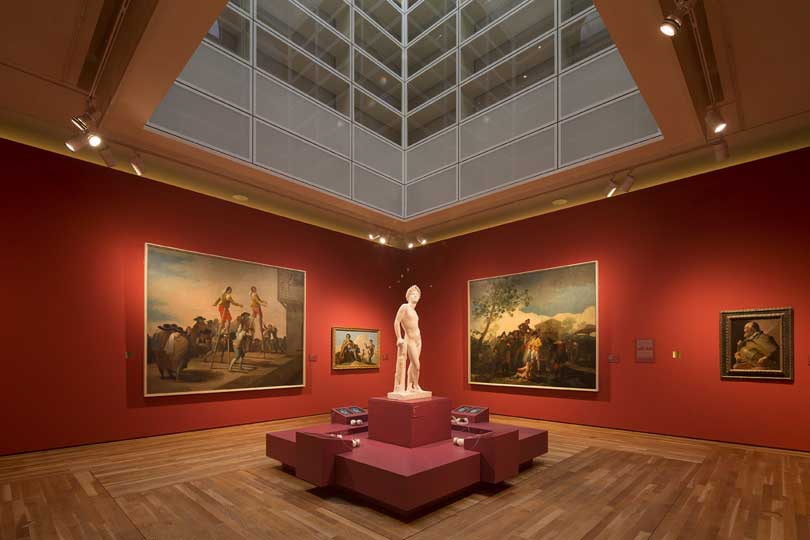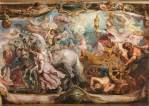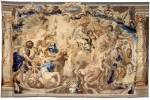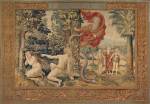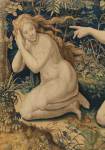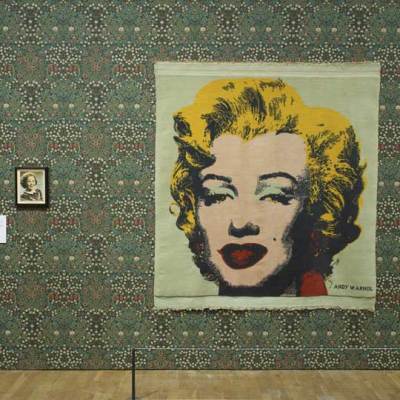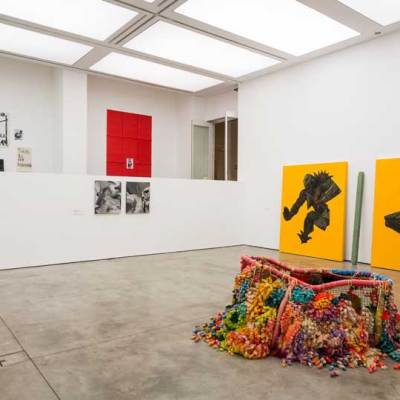After Henry VIII died in 1547, his inventory listed over 2,700 tapestries for his 14 palaces and lesser homes – and this did not include bed, wall or window hangings. So, when Thomas Campbell staged his landmark show of Renaissance tapestries (‘Tapestry in the Renaissance: Art and Magnificence’) at the Metropolitan Museum of Art in New York in 2002, which included some of Henry’s pieces, it pulled unexpected crowds of visitors. They were agog: gallery after huge gallery was lined ceiling to floor with brightly-coloured, painstakingly woven compositions of courtiers going hunting; a gory Massacre of the Innocents; a passionate Lamentation; a dragon fighting a panther. This, they learnt, was how the Renaissance super-rich decorated their homes, their version of having a few big Warhols on the walls.
Tapestries were the principal way of displaying wealth, power, magnificence, or even piety when given to a monastery. Rulers sometimes kept tapestry docents on hand to educate visiting diplomats on their master’s extravagant hangings. Designed by top artists from Raphael to Rubens, most were woven in northern Europe.
Campbell – soon nicknamed ‘Tapestry Tom’ – kickstarted a global movement for institutions and museums who owned these gorgeous creations to look in their basements and unroll treasures than had not been on public display for decades, even centuries. He followed up with another blockbuster show, this time on baroque tapestries (‘Tapestry in the Baroque: Threads of Splendor’; 2007). Tapestry study moved into the mainstream of art historical research and conservation, and is the now the subject of major shows in three large museums: the Prado in Madrid, the Getty in Los Angeles and – as expected – again at the Met.
At the end of last month, the Prado opened ‘Goya in Madrid: The Tapestry Cartoons 1775–1794’ (until 3 May 2015). The show explores the commission Francisco José de Goya y Lucientes (1746–1828) received in 1775 when, aged 29, he was called to Madrid by court painter Anton Raphael Mengs. His job was to prepare full-scale preparatory paintings on canvas to decorate Charles III’s El Pardo and El Escorial palaces. Over the next two decades he produced seven series of designs, while painting his great court and royal portraits and becoming, jointly with his brother-in-law the painter Ramón Bayeu, Painter to the King. The show’s 142 works focus not on the cartoons’ architectural context. Rather, it looks at how Goya’s vibrant designs tell the story of his artistic development as he studied the Spanish Royal Collection, which was rich in inspirational historic pictures by Titian, Rubens, Teniers and Velázquez, as well as contemporary works by Mengs, Bayeu, Tiepolo and others. With Spain’s government arts funding slashed, AXA Foundation’s essential financial support here is perhaps a blueprint for how other private institutions in Spain can step in.
Those going to Madrid can also visit the still operational Royal Tapestry Factory down behind Atocha railway station, as well as the riverside Ermita de San Antonio de la Florida whose interior is coated with Goya’s lively frescoes made in 1798 for Charles IV (Goya is buried here, too), and, of course, see the tapestries themselves at El Pardo and El Escorial, both a train ride away.
Across the Atlantic, the Getty’s ‘The Triumph of the Eucharist’ (until 11 January) displays more Prado treasures. The magnificent tapestries from Peter Paul Rubens’s ‘Eucharist’ series (made in Brussels between 1625 and 1633) are hung with their modelli from the Prado’s collection, offering a rare chance to compare developments from first ideas to finished works. One of the most lavish sets of religious tapestries ever made – costing millions of dollars in today’s value – they were commissioned by Philip II’s favourite daughter, the powerful and pious Infanta Isabel Clara Eugenia, governor-general of Spain’s Netherlands territories, for her beloved Monasterio de las Descalzas Reales (Convent of the Barefoot Royals) in Madrid.
‘Grand Design: Pieter Coecke van Aelst and Renaissance Tapestry’, installation view. Image courtesy of the Metropolitan Museum

The Met’s show is the most spectacular of the three. Here, building on Campbell’s trailblazing work and global connections, ‘Grand Design: Pieter Coecke van Aelst and Renaissance Tapestry’ borrows internationally to stage the museum’s most theatrical show of the year, and one of its most fascinating. Coecke (1502–50) was a grand master of design proficient in panel painting, stained glass and tapestry. But it was tapestry that allowed him to reach his full potential as he worked for Europe’s most powerful patrons – Charles V, François I, Cosimo de Medici and Henry VIII. Nineteen of his designs have been brought together. The show starts quietly with Coecke’s early life. Then, turning a corner, three high-ceilinged galleries have been dissolved into one great long, wide vista wall-papered with tapestry. In a brilliant museum moment of drama and awe, the stage is set for Henry VIII to swagger in.
‘Spectacular Rubens: The Triumph of the Eucharist’ is reviewed at length by Louise Nicholson in the December issue of Apollo
‘Goya in Madrid’ is at the Museo Nacional del Prado, Madrid, until 3 May 2015.
‘Spectacular Rubens: The Triumph of the Eucharist’ is at the Getty Center, Los Angeles, until 11 January 2015; then at the Museum of Fine Arts, Houston, from 15 February–10 May 2015.
‘Grand Design: Pieter Coecke van Aelst and Renaissance Tapestry’ is at the Metropolitan Museum of Art, New York, until 11 January.
Related Articles
A Woven Palette: ‘Spectacular Rubens’ at the Getty (Louise Nicholson)
Review: Sumptuous 18th-century tapestries at the Galerie des Gobelins (Jamie Mulherron)
Trading Stories: textiles, taste and commerce (Louise Nicholson)
Cutting off: Alison Watt’s tapestry for Scottish Opera unveiled at Dovecot Studios (Claudia Massie)
Go With The Flow: William Morris and Andy Warhol at Modern Art Oxford (Matilda Bathurst)

